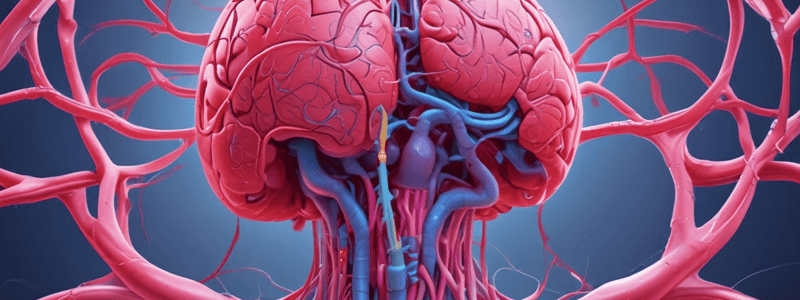Podcast
Questions and Answers
What is the main function of the pulmonary circulation?
What is the main function of the pulmonary circulation?
- To transport oxygenated blood from the left ventricle to the aorta
- To exchange respiratory gases (O2 and CO2) (correct)
- To transport deoxygenated blood from the right ventricle to the left atrium
- To act as a blood reservoir
What is the relationship between pressure, volume, and resistance in the pulmonary circulation?
What is the relationship between pressure, volume, and resistance in the pulmonary circulation?
- Pressure, volume, and resistance are all inversely proportional
- Pressure and volume are directly proportional, while resistance is inversely proportional (correct)
- Pressure, volume, and resistance are all directly proportional
- Pressure and resistance are directly proportional, while volume is inversely proportional
What is the characteristic of the pulmonary capillaries?
What is the characteristic of the pulmonary capillaries?
- They have a small diameter and few anastomoses
- They have a large diameter and many anastomoses (correct)
- They have a large diameter and few anastomoses
- They have a small diameter and are highly muscular
What is the pressure in the pulmonary circulation compared to the systemic circulation?
What is the pressure in the pulmonary circulation compared to the systemic circulation?
What is the deoxygenated blood flow path in the pulmonary circulation?
What is the deoxygenated blood flow path in the pulmonary circulation?
What is the function of the cutaneous circulation?
What is the function of the cutaneous circulation?
What is the role of the blood-brain barrier in the cerebral circulation?
What is the role of the blood-brain barrier in the cerebral circulation?
What is the primary function of pulmonary capillaries?
What is the primary function of pulmonary capillaries?
What is the mean pulmonary artery pressure?
What is the mean pulmonary artery pressure?
How does the sympathetic nervous system affect the pulmonary circulation?
How does the sympathetic nervous system affect the pulmonary circulation?
What is the effect of hypoxia (decreased oxygen tension) on the pulmonary circulation?
What is the effect of hypoxia (decreased oxygen tension) on the pulmonary circulation?
How does gravity affect the pulmonary circulation?
How does gravity affect the pulmonary circulation?
What is the relationship between pulmonary blood flow and pulmonary resistance?
What is the relationship between pulmonary blood flow and pulmonary resistance?
How does the pulmonary resistance compare to the systemic resistance?
How does the pulmonary resistance compare to the systemic resistance?
In the standing position, the pattern of pulmonary blood flow is:
In the standing position, the pattern of pulmonary blood flow is:
The primary function of arterioles in the cutaneous circulation is:
The primary function of arterioles in the cutaneous circulation is:
The 'white line reaction' observed in the cutaneous circulation is caused by:
The 'white line reaction' observed in the cutaneous circulation is caused by:
Which of the following is NOT a stage of the 'triple response of Lewis' in the cutaneous circulation?
Which of the following is NOT a stage of the 'triple response of Lewis' in the cutaneous circulation?
The cerebral blood flow is approximately:
The cerebral blood flow is approximately:
The blood flow to the gray matter of the brain is _____ times higher than the blood flow to the white matter.
The blood flow to the gray matter of the brain is _____ times higher than the blood flow to the white matter.
The cerebral circulation is particularly sensitive to ischemia and hypoxia due to:
The cerebral circulation is particularly sensitive to ischemia and hypoxia due to:
Which of the following is true about brain metabolism?
Which of the following is true about brain metabolism?
What is the approximate volume of cerebrospinal fluid (CSF) surrounding the brain?
What is the approximate volume of cerebrospinal fluid (CSF) surrounding the brain?
Which of the following is NOT a function of cerebrospinal fluid (CSF)?
Which of the following is NOT a function of cerebrospinal fluid (CSF)?
What is the primary function of the blood-brain barrier?
What is the primary function of the blood-brain barrier?
Which of the following is NOT a component of the blood-brain barrier?
Which of the following is NOT a component of the blood-brain barrier?
What is the primary function of the pulmonary circulation?
What is the primary function of the pulmonary circulation?
Which of the following factors does NOT affect resistance in the pulmonary circulation?
Which of the following factors does NOT affect resistance in the pulmonary circulation?
What is the primary function of the cutaneous circulation?
What is the primary function of the cutaneous circulation?
Which of the following statements about the cerebral circulation is NOT true?
Which of the following statements about the cerebral circulation is NOT true?
Flashcards are hidden until you start studying




